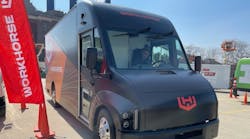With the explosive growth of ecommerce fueled in part by the pandemic, a lot of attention has been focused on last-mile delivery, which is typically served by vans and step vans.
The Classes 3, 4, 5, and 6 markets with respect to vans and step vans is large, dwarfing the estimated 2 million active Classes 7 and 8 tractors hauling freight. We conservatively estimate the active Class 3, 4, 5 and 6 van and step van market in the U.S. and Canadian to be about 4.2 million vehicles.
We believe the nature of this market segment makes it ripe for electrification based on duty-cycle factors. These vehicles typically do not travel far from their home base which they return to at the end of each day and weight is not a big consideration for them.
While we tend to think of vans and steps vans as being used for package delivery, they are used in a host of other ways, including by contractors, vending supply companies, dry cleaners, and more.
See also: NACFE demonstrates use case for electric vans and step vans
During Run on Less – Electric (RoL-E) we had a chance to observe the day-to-day workings of one van and two step vans. DHL operating a series production Lightning eMotors Transit 350 HD delivered packages in New York City. Purolator operated a production Motiv Class 6 step van to deliver packages in Vancouver, British Columbia. Servall Electric operated a series production Class 5 Workhorse C1000 step van to deliver electrical supplies in Cincinnati.
The top-level takeaway from RoL-E is that if all 4,143,406 vans and step vans in the U.S. and Canada were electric, 43,476,632 MT of CO2e would be prevented from entering the atmosphere each year.
Another key finding that we outlined in our recently released report, Electric Trucks Have Arrived: The Use Case for Vans and Step Vans, is that everything around electrifying smaller commercial vehicles is easier and the total cost of ownership (TCO) for this market segment is approaching parity with diesel- and gasoline-powered vehicles.
We also believe that these EVs will improve driver attraction and retention because they are easy to operate and because of the “cool factor” associated with them. RoL-E drivers in this market segment as well as those from the other three segments we studied commented on how they like the fact that they are not polluting the environment when they are driving an electric vehicle at work.
We know the transition to EVs will be challenging, but we also know that planning can help mitigate some of the risks. Electrification will not happen overnight and redesigning parking lots and depots to support electrification will take time, effort, and money. Despite these challenges, battery-electric vehicles are a perfect fit for the van and step van market segments.
In fact, NACFE believes this market segment is 100% electrifiable. We’re happy to talk with fleets that want to begin their electrification journey in this market segment.
Michael Roeth has worked in the commercial vehicle industry for nearly 30 years, most recently as executive director of the North American Council for Freight Efficiency. He serves on the second National Academy of Sciences Committee on Technologies and Approaches for Reducing the Fuel Consumption of Medium and Heavy-Duty Vehicles and has held various positions in engineering, quality, sales, and plant management with Navistar and Behr/Cummins.




